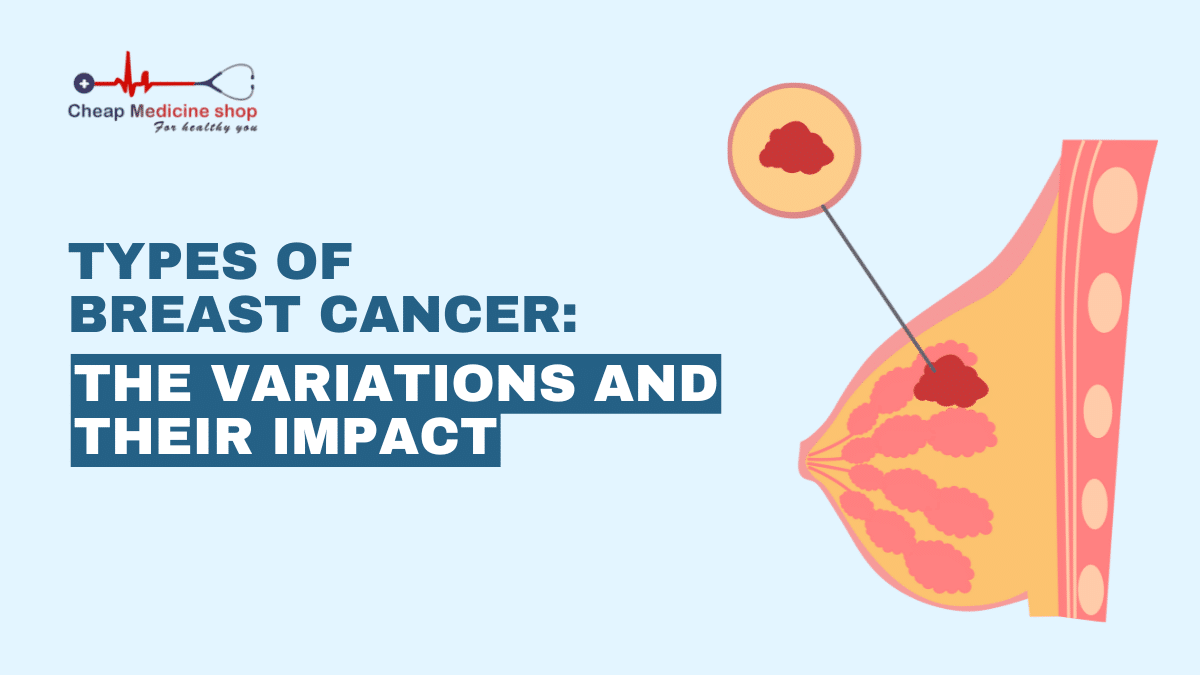Breast Cancer affects over 2 million women worldwide each year, making it one of the most common Cancers. Yet many people don’t realize that types of Breast Cancer vary widely, each with unique symptoms, treatments, and survival outcomes.
Knowing which type you’re dealing with is crucial, whether you’ve recently been diagnosed or are supporting someone who has. From the more common ductal carcinomas to harder-to-detect Inflammatory Cancers, each presents its challenges.
So, read on to know more about the different types of Breast Cancer and how each one is managed.
Most common types of Breast Cancer
Breast Cancer begins either in the ducts that carry milk or in the lobules that produce it. The most frequently diagnosed types include:
Save up to 90% on your medicine bills

Abraxane 100 Mg Injection

Alphalan 5 Mg Tablets

Adriamycin 50 Mg Injection

Abirapro 250 Mg Tablet
Ductal Carcinoma In Situ (DCIS)
DCIS is a pre-invasive or non-invasive Cancer of the breast where abnormal cells remain contained within the milk ducts without spreading to surrounding tissue. It accounts for about 20-25% of Breast Cancer cases and is sometimes called “stage 0”.
Key characteristics:
- Usually detected through mammography as microcalcifications.
- Highly treatable with a nearly 100% survival rate.
- Treatment typically involves breast-conserving surgery (lumpectomy) followed by radiation therapy, or mastectomy in some cases.
Invasive Ductal Carcinoma (IDC)
IDC is the most common type of Breast Cancer, representing about 70-80% of all invasive Breast Cancers. It starts in a milk duct but grows beyond the duct walls into surrounding breast tissue.
Key characteristics:
- May present as a lump that feels harder than the surrounding tissue.
- IDC can metastasize (spread) to lymph nodes and other parts of the body if not treated early.
- Treatment depends on staging but often includes surgery, radiation, and systemic therapy (chemotherapy, hormone therapy, or targeted therapy).
Invasive Lobular Carcinoma (ILC)
ILC starts at the milk-producing glands (lobules) and is the second most common type of invasive Cancer of the breast, accounting for 5-15% of cases.
Key characteristics:
- Often presents as a thickening or fullness in the breast rather than a distinct lump.
- It may be harder to detect on mammograms than Ductal Carcinoma.
- More likely to occur in both breasts than in other types.
- Treatment approaches are similar to IDC but may require additional imaging to determine the extent.
Molecular subtypes of Breast Cancer
Beyond location, Breast Cancers are classified by their molecular characteristics, which significantly impact treatment decisions:
Hormone receptor-positive Breast Cancer
This is the most common Breast Cancer subtype, with cells having receptors for Estrogen (ER+), Progesterone (PR+), or both.
Key characteristics:
- It accounts for about 70% to 80% of Breast Cancers.
- Often responds well to hormone therapy that blocks Estrogen effects.
- Generally has a favorable prognosis compared to other subtypes.
- Treatment typically includes hormone therapy, such as Tamoxifen or aromatase inhibitors.
HER2-positive Breast Cancer
About 15-20% of Breast Cancers have excessive HER2 protein, which promotes Cancer cell growth.
Key characteristics:
- Tends to be more aggressive than hormone receptor-positive types.
- Before targeted therapies, patients had a worse prognosis.
- Now has excellent treatment options with HER2-targeted medications like Trastuzumab (Herceptin).
- Often treated with a combination of targeted therapy and Chemotherapy.
Triple-negative Breast Cancer
Triple-negative Breast Cancer (TNBC) lacks receptors for Estrogen, Progesterone, and HER2 protein, making it more challenging to treat.
Key characteristics:
- Represents 10-15% of Breast Cancers.
- More likely to affect younger women and African American women.
- Often more aggressive and is associated with higher recurrence rates and poor survival rates.
- Treatment primarily relies on chemotherapy, with newer options including immunotherapy in some instances.
Inflammatory Breast Cancer
Inflammatory Breast Cancer is an aggressive Cancer of the breast that accounts for 1-5% of Breast Cancers and often develops rapidly.
Key characteristics:
- Presents with swelling, redness, and warmth in the breast rather than a distinct lump.
- Often missed on mammograms due to its diffuse nature.
- Has a higher risk of metastasis due to delayed diagnosis.
- Treatment for Inflammatory Cancer of the breast begins with chemotherapy, followed by surgery and radiation.
Paget’s disease of the breast
It occurs in the ducts and spreads to the areola (dark skin around the nipple) and nipple.
Key characteristics:
- Presents as crusty, scaly skin on the nipple, often resembling eczema.
- May cause burning, itching, or bloody discharge from the nipple.
- Almost always associated with an underlying Cancer (either DCIS or invasive).
- Treatment depends on the underlying Cancer but often includes surgery and additional therapies.
Medullary Carcinoma
A subtype of Invasive Ductal Carcinoma with distinctive features under the microscope.
Key characteristics:
- Accounts for about 3-5% of Breast Cancer.
- Often presents as a soft, fleshy tumor with well-defined boundaries.
- Tends to grow or spread slowly and has a better prognosis than most other invasive Cancers.
- Treatment follows standard Breast Cancer protocols.
Tubular Carcinoma
A subtype of Invasive Ductal Carcinoma is characterized by tubule-shaped structures under the microscope.
Key characteristics:
- Makes up about 1-2% of Breast Cancers.
- Usually small and low-grade.
- It is a low-risk Cancer of the breast and has an excellent prognosis with high survival rates.
- Treatment may be less aggressive than for other invasive Cancers.
Metaplastic Breast Cancer
A rare and diverse group of invasive Breast Cancers where cells have transformed into a different cell type.
Key characteristics:
- Very rare, accounting for less than 1% of Breast Cancers.
- Often larger and faster-growing than other types.
- Frequently triple-negative.
- May be less responsive to standard treatments.
Mucinous Carcinoma
A form of Invasive Ductal Carcinoma where Cancer cells produce mucin, a principal component of mucus.
Key characteristics:
- It accounts for about 2-3%
- Often presents as a soft, bulky tumor
- Usually grows slowly and has a better prognosis
- Treatment follows standard protocols but may be less aggressive
Papillary Carcinoma
It is characterized by finger-like projections when viewed under a microscope.
Key characteristics:
- Makes up less than 1% of invasive Cancers of the breast
- Most commonly diagnosed in older women
- Often detected on mammograms as well-defined masses
- Generally has a good prognosis
Male Breast Cancer

Though rare, men can develop Breast Cancer, with about 2,800 new cases diagnosed annually in the United States.
Key characteristics:
- The most common type in men is invasive Ductal Carcinoma.
- Often diagnosed at later stages due to lower awareness
- Treatment follows similar protocols to female Breast Cancer
- Hormone receptor-positive status is more common in men than women
Phyllodes tumors
These breast tumors develop in the connective tissue rather than the ducts or lobules.
Key characteristics:
- Can be benign, borderline, or malignant
- Typically present as a rapidly growing, painless lump
- Treatment is primarily surgical removal with clear margins.
- Rarely spreads to lymph nodes, but malignant forms can metastasize.
Conclusion
Knowing the different types of Breast Cancer can help people understand their diagnosis better and make informed decisions. While common types like IDC and ILC make up most cases, some, like Paget’s disease or triple-negative, can be more complex.
These days, doctors use detailed lab tests to match treatment to the Cancer’s traits, which helps improve outcomes. Some types, especially those not detected by a mammogram, may be more complex to catch early.
It is essential to get timely checkups and talk to your doctor about any changes. Always ask your healthcare provider about your Cancer type, whether it’s likely to spread, and what the best treatment options are for you.

Frequently Asked Questions
What type of collagen causes Breast Cancer?
No, a specific type of collagen does not directly cause Breast Cancer. However, research shows that abnormal collagen architecture and alignment in breast tissue may create a microenvironment that promotes tumor growth and invasion. This involves complex interactions between Cancer cells and the surrounding extracellular matrix.
Does Breast Cancer type affect survival rate?
Breast Cancer type significantly impacts survival rates. Generally, non-invasive types like DCIS have an excellent prognosis (nearly 100% survival), while inflammatory and certain triple-negative Cancers have lower survival rates. Stage at diagnosis, however, remains the strongest predictor of outcome.
Are there Breast Cancer types unique to younger women?
While no Breast Cancer type exclusively affects young women, specific aggressive subtypes are more common in younger patients. Triple-negative Breast Cancer occurs more frequently in women under 40, particularly those with BRCA1 mutations, and pregnancy-associated Breast Cancer presents unique challenges for younger women.
What are the most aggressive types of Breast Cancer?
The most aggressive types of Breast Cancer include triple-negative, inflammatory, and untreated HER2-positive Cancers. These grow quickly and are often harder to treat. Early diagnosis, fast treatment, and personalized care are essential for better outcomes with these aggressive subtypes.
Which Breast Cancer types are challenging to detect on mammograms?
Breast Cancer types like invasive lobular Carcinoma and Inflammatory Breast Cancer are more complex to detect on mammograms. These Cancers may not form clear lumps and often require additional tests like MRI or ultrasound for accurate diagnosis.
What type of Breast Cancer causes calcifications?
Ductal Carcinoma In Situ (DCIS) commonly causes microcalcifications visible on mammograms. These tiny calcium deposits form in dying Cancer cells within the milk ducts. Certain invasive Cancers can also cause calcifications, though their pattern typically differs from the fine, clustered appearance of DCIS calcifications.
Can Breast Cancer type change after recurrence?
Yes, Breast Cancer can change its biological characteristics upon recurrence. About 20-30% of recurrent tumors show different hormone receptor or HER2 status compared to the original tumor. This phenomenon, called discordance, may require different treatment approaches for the recurrent disease.
What type of Breast Cancer is most likely to metastasize?
Triple-negative and HER2-positive Breast Cancers have higher rates of metastasis, particularly when diagnosed at later stages. Inflammatory Breast Cancer also has a high metastatic potential due to its aggressive nature and tendency to involve lymphatic vessels early in disease progression.
Cheap Medicine Shop only refers to credible, authoritative sources for our content. If you’re curious about how we ensure the integrity of our content, we encourage you to read our Content Information Policy.














